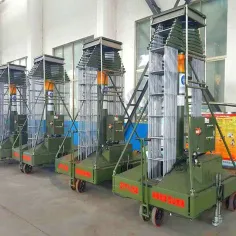How to Choose a Hydraulic Cylinder Size?
Have you ever found yourself in a situation where you needed a hydraulic cylinder, only to be overwhelmed by the myriad of sizes available? I certainly have. Picture this: you're working on a DIY project, perhaps building a hydraulic press for your workshop. Everything is going smoothly until you hit a roadblock – selecting the right hydraulic cylinder size. It's like trying to find a needle in a haystack. But fear not, as this article aims to unravel the mystery of choosing the perfect hydraulic cylinder size in a way that's easy to grasp.

The Conundrum of Hydraulic Cylinder Sizes: A Personal Odyssey
It all started when I decided to build a custom hydraulic press for my garage. Excitement was high, and I dove into the project headfirst. However, as I started shopping for a hydraulic cylinder, I found myself drowning in a sea of sizes and specifications. It was confusing, to say the least. Why on earth are there so many options? I wondered.
The Importance of Choosing the Right Size
Before we delve into the nitty-gritty details, let's understand why selecting the right hydraulic cylinder size is crucial. Think of it as choosing the right pair of shoes – too big, and they'll flop around; too small, and you're in for a world of discomfort. Similarly, a hydraulic cylinder that's too big or too small for your application can lead to inefficiency, increased energy consumption, and even damage to your equipment. It's all about finding that sweet spot.
Breaking Down the Basics: Understanding Hydraulic Cylinder Sizes
Let's simplify things. Hydraulic cylinder sizes essentially boil down to two key factors: bore diameter and rod diameter. The bore diameter is the internal diameter of the cylinder, while the rod diameter is the diameter of the rod extending from the cylinder. These two factors play a pivotal role in determining the force and speed of the hydraulic system.
To put it in layman's terms, imagine the bore diameter as the engine of your car – the larger it is, the more power it can generate. On the other hand, the rod diameter is like the gear ratio – affecting the speed and precision of your hydraulic system. Now, armed with this basic knowledge, let's move on to the practical steps of choosing the right size for your needs.
Step 1: Define Your Application Needs
The first step in this journey is understanding your application. What are you using the hydraulic cylinder for? Is it a heavy-duty industrial application, or a smaller, more precise task? Knowing the force and speed requirements of your application will guide you in selecting the appropriate bore and rod diameters.
Step 2: Calculate the Required Force
Now, let's get a bit technical but fear not, I'll keep it simple. Calculate the force your hydraulic cylinder needs to exert. It's as easy as multiplying the pressure (in pounds per square inch, or PSI) by the area of the piston (π times the square of the bore radius). This gives you the force in pounds. Matching this force requirement to a cylinder with the right bore diameter is key to optimal performance.
Step 3: Consider Speed and Precision
Once you've figured out the force, think about the speed and precision your application demands. If you need a fast and precise movement, a smaller rod diameter might be suitable. Conversely, for heavy-duty tasks that require slower, more powerful movements, a larger rod diameter is preferable.
Conclusion: Navigating the World of Hydraulic Cylinder Sizes
In conclusion, choosing the right hydraulic cylinder size is a blend of art and science. Understanding your application, calculating the force requirements, and considering speed and precision are the essential steps. Remember, it's not about finding the biggest or the smallest cylinder; it's about finding the one that fits just right, like Goldilocks and her porridge.
As you embark on your hydraulic journey, armed with the knowledge shared here, may you navigate the vast sea of cylinder sizes with confidence. So, the next time you're faced with the perplexing array of options, you can smile, knowing that you are equipped to make the right choice – a choice that ensures optimal performance and longevity for your hydraulic system. Happy building!


